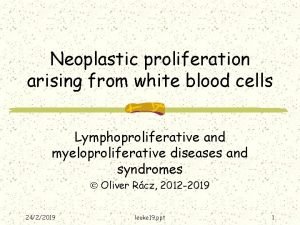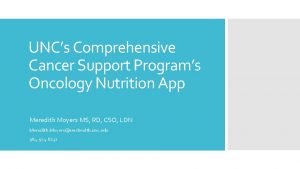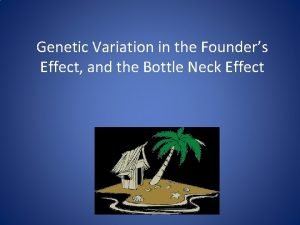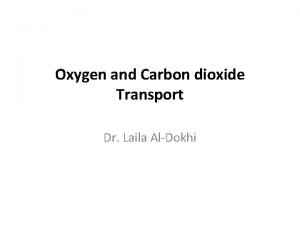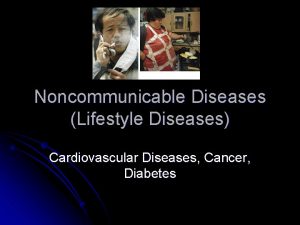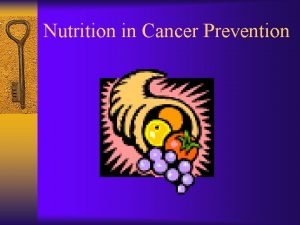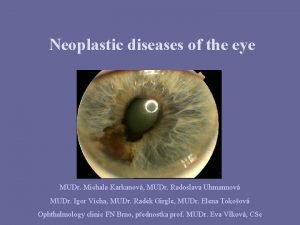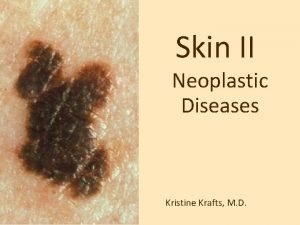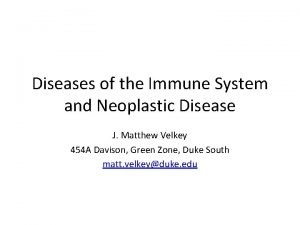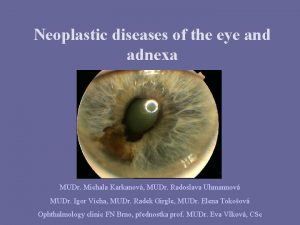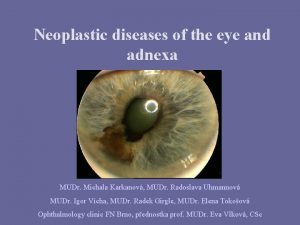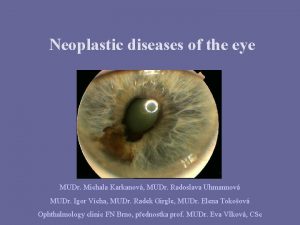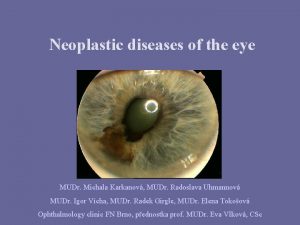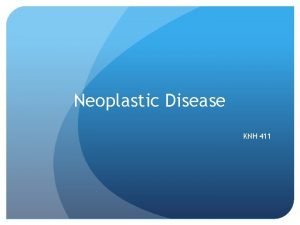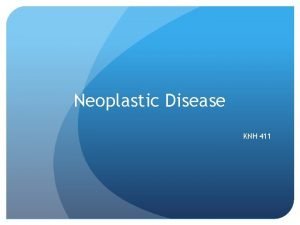Nutrition of Neoplastic Diseases The effect of Cancer



















- Slides: 19

Nutrition of Neoplastic Diseases

ØThe effect of Cancer on nutritional status • The cancer cachexia syndrome, characterised by marked weight loss, anorexia (loss of appetite), early satiety, dysgeusia (loss of taste), dysphagia (disorder of swallowing), fatigue, asthenia and anaemia, reduction of fat and lean body masses, is invariably associated with the presence and growth of the tumour. • Depending upon the site of the cancer, digestion and absorption of nutrients may be disturbed (e. g. owing to diarrhoea, malabsorption). • The competition for nutrients between the tumour and the host leads to an accelerated starvation state that promotes severe metabolic disturbances in the host, including hypermetabolism, which leads to decreased energetic efficiency.

• The most important carbohydrate abnormalities are increased glucose synthesis, gluconeogenesis and Cori cycle activity, and decreased glucose tolerance and insulin resistance • Proteolysis and lipolysis are accelerated, while muscle protein synthesis is depressed, resulting in a loss of lean body mass and fat tissue • The main abnormalities found in lipid metabolism are enhanced lipid mobilisation, decreased lipogenesis, decreased lipoprotein lipase activity, elevated triglycerides and decreased high-density lipoproteins, increased venous glycerol and decreased glycerol clearance from the plasma

• Alterations in metabolism are partially mediated by changes in circulating hormone concentrations (insulin, glucagon and glucocorticoids, in particular) or in their effectiveness. • A number of pro-inflammatory cytokines, released mainly by immune cells, including interleukin (IL)-1, IL-6, tumour necrosis factor (TNF)-α, interferon (IFN)- α and IFN-γ, have been implicated in the pathogenesis of cachexia associated with human cancer. • A depletion of muscle mass is not substantially reversible with any of the currently available nutritional, metabolic or pharmacological approaches.

• In addition to, oncology treatment such as surgery, chemotherapy and radiotherapy produce additional acute and chronic symptoms which increase energy expenditure and decrease food intake (e. g. by changes in taste, dry mouth, nausea, vomiting) and nutritional status

Ø Main consequences of cancer cachexia syndrome. – – – – – Impaired quality of life. Reduced response to chemotherapy. Increased risk of chemotherapy-induced toxicity. Impaired immune competence. Reduced performance status and muscle function. Increased risk of postoperative complications. Longer hospital stay. Higher prescription and consultation rates. Shorter survival time.

ØThe energy and protein requirements of cancer patients • Generally, cancer itself does not affect resting energy expenditure (REE). • The energy requirements of cancer patients should therefore be assumed to be normal unless there are specific data showing otherwise. • Total energy expenditure (TEE) for non-obese patients using the actual body weight: – ambulant patients: 30– 35 kcal/kg body weight/day – bedridden patients: 20– 25 kcal/kg body weight/day • These assumptions are less accurate for severely underweight (actual TEE per kg is higher in this group) and for severely overweight subjects (actual TEE per kg is lower). • The optimal protein supply for cancer patients cannot be easily determined. • Recommendations range from a minimum protein supply of 1 g/kg body weight/day to a target supply of 1. 2– 2 g/kg body weight/day.

Ø Effects of radiotherapy on dietary intake • The effect of radiotherapy on a patient’s nutritional status depends on the extent of body area irradiated, as well as the type, quantity and duration of radiotherapy and the individual’s response. • Gastrointestinal mucosa is highly vulnerable to radiation therapy, with the common emetic adverse effects having an obvious impact on food intake. • Radiation therapy also has a direct toxic effect on the taste buds of the tongue and their innervating nerve fibres, as well as on the microvilli of the gastrointestinal mucosa;

• Radiation therapy to the head and neck region, including cancer of the mouth, tongue, salivary glands, throat and face, has been associated with anorexia, oesophagitis, xerostomia, nausea, vomiting, dysphagia, odynophagia (pain during swallowing), sore throat, alterations in taste and smell • Radiation to the abdomen or pelvic area, including cancer of the cervix, colon, rectum, pancreas and prostate, may cause acute diarrhoea, anorexia, nausea, vomiting, abdominal pain, enteritis and colitis, and in severe cases ulceration and perforation, owing to irradiation damage of the gastrointestinal mucosa • A profound long-term effect on nutritional status is chronic radiation enteropathy. • Radiation-induced diarrhoea may require some changes in the patient’s diet, the most common of which are reduction in fiber, fat or lactose. • Therefore, in these cases regular nutritional assessment is very important.

ØThe main nutrition-related side effects of chemotherapy • Loss of appetite – Consume small and frequent meals, when appetite is best. – Serve food in manageable portions. The sight of large portions is off-putting. – Eat slowly, chew well and relax between courses and after a meal. – Eat anything that is particularly fancied. – Do not consume large quantities of liquids before or during meals. – A short walk before a meal may help appetite. – Avoid exposure to cooking smells during food preparation

• Loss of taste – Choose foods full of flavour and aroma. – Use seasonings (e. g. vinaigrette), herbs (e. g. basil, oregano, garlic), spices (e. g. curry, pepper, sweet paprika), lemon juice to enhance flavour. – Lemon juice in water before food may be helpful. • Changes in taste – Avoid any food with an unpleasant taste. – Allow hot food to cool before eating since high temperature enhances unpleasant taste. – If meat tastes unpleasant, consume other sources of high biological value proteins. – If you experience a metallic taste, a small portion of lemon juice in water before eating may help

• Xerostomia (dry mouth) – Moisten meals by adding sauces, seasonings, gravy, cream or evaporated milk. – Avoid grilling or frying as cooking methods and prefer others that maintain moisture (e. g. pressure cooking, steaming, boiling). – Avoid dry/rough foods (e. g. toasts, biscuits, crackers, cereal bars, crisps). – Sip liquids during meals. – Prefer sharp-tasting foods (e. g. those flavoured with lemon, grapefruit and rhubarb). • Sore or painful mouth – – Eat soft, moist foods. Avoid very dry or rough-textured foods (see above). Avoid salty or spicy foods. Avoid orange, grapefruit and lemon juice, as well as vinegar.

ØNutrition of immunosuppressed patients • Treatment of leukaemia and other haematological malignancies often involves bone marrow or peripheral blood cell transplantation and requires patient immunosuppression. • Immunosuppressed patients should therefore avoid: • uncooked food or have been exposed to air and hence likely to be contaminated with bacteria or fungi. – raw or undercooked meat, fish, shellfish, eggs or unpasteurised milk, processed meats like salami and pate´ , sushi, ‘live’ or ‘bio’ yoghurt, soft cheeses (e. g. Brie, Camembert, cottage cheese, Roquefort), mayonnaise. – raw vegetables and fruits with skins or which are partially damaged.

– foods in opened containers or shared by others (e. g. large cartons of ice cream, jars of jam, bottled sauces). – foods that are approaching their ‘use by’ date. – cooking methods such as microwave or cook-chill systems and barbecued food. – reheating already heated food and refreezing thawed frozen foods. – storing raw and cooked food together. – eating and drinking away from home.

Ø Enteral nutrition for cancer patients • Impaired caloric intake, altered metabolism and an increased inflammatory response all contribute to malnutrition. • Enteral nutrition or tube feeding is a critical therapy for treating malnutrition associated with cancer and is indicated in any malnourished patient with a functional gastrointestinal tract who is unable to ingest sufficient nutrients orally, as long as enteral access can safely be achieved. • Enteral nutrition is preferred over parenteral nutrition because it is more physiological, simpler, safer and less costly.

• Common indications include dysphagia due to head and neck cancer, oesophageal obstruction, gastric outlet obstruction or critical illness requiring prolonged mechanical ventilation. • Moreover, in patients experiencing anorexia or aversion to certain food groups (e. g. meat), oral nutritional supplements may help achieve required energy and protein intakes. • Cancer patients undergoing major abdominal surgery, are recommended for preoperative enteral nutrition, preferably with immune modulating substrates for 5– 7 days independent of a patient’s nutritional status. • Various nutrients, including arginine, glutamine, omega -3 fatty acids and polyribonucleotide (RNA), have been shown to alter the immune response.

Ølifestyle recommendations for cancer prevention • Recommendation 1: Body Fatness – Be as lean as possible within the normal range (according to WHO or national governments) of body weight. – Avoid weight gain and increases in waist circumference throughout adulthood • Recommendation 2: Physical Activity – Be physically active as part of everyday life (brisk walking for at least 30 minutes/day. – As fitness improves, increase to 60 minutes or more of moderate or to 30 minutes or more of vigorous physical activity/day. • Recommendation 3: Foods and drinks that promote weight gain – Limit consumption of energy-dense foods (energy content >225 -275 kcal/100 g). – Average energy density of diets should be lowered towards 125 kcal/100 g. – Avoid sugary drinks (mostly those with added sugars; however, fruit juices should be also limited).

• • • Recommendation 4: Plant foods – Eat mostly foods of plant origin. – Population average consumption of non-starchy vegetables and fruits should be at – least 600 g (21 oz) daily. Individuals should consume at least five portions/servings (i. e. 400 g or 14 oz) of a variety of non-starchy vegetables and fruits per day. – Eat relatively unprocessed cereals (grains) and/or pulses (legumes) with every meal. – Limit refined cereals. Recommendation 5: Animal foods – Limit intake of red meat (beef, pork, lamb and goat) and avoid processed meat (meat – preserved by smoking, curing or salting or addition of chemical preservatives). – Population average consumption of red meat should be no more than 300 g (11 oz) per week. – Goal for the individual is consumption of less than 500 g (18 oz) per week of red meat and very little if any to be processed. Recommendation 6: Alcoholic drinks – Limit alcoholic drinks. – Children and pregnant women should not consume alcoholic drinks.

• • Recommendation 7: Preservation, processing, preparation – Limit consumption of salt. Avoid mouldy cereals or pulses (aflatoxin contamination risk). – Population average consumption of salt from all sources should be less than 5 g (2 gof sodium) per day. – On an individual basis salt consumption should be limited to less than 6 g (2. 4 g of sodium) per day. – Methods of preservation that do not or need not use salt include refrigeration, freezing, drying, bottling, canning and fermentation. Recommendation 8: Dietary supplements – Aim to meet nutritional needs through diet alone. – In some cases of illness or dietary inadequacy, supplements may be valuable. Dietary supplements are not recommended for cancer prevention. Special recommendation 1: Breastfeeding – Mothers to breastfeed; children to be breastfed. – Aim to breastfeed infants exclusively up to six months and continue with complementary feeding thereafter. Special recommendation 2: Cancer survivors – Follow the recommendations for cancer prevention.
 Reed sternberg cells
Reed sternberg cells Non neoplastic epithelial disorders
Non neoplastic epithelial disorders Nutrition app cancer
Nutrition app cancer Founder effect vs bottleneck effect
Founder effect vs bottleneck effect Slutsky equation
Slutsky equation Bohr's effect in respiration
Bohr's effect in respiration Làm thế nào để 102-1=99
Làm thế nào để 102-1=99 Lời thề hippocrates
Lời thề hippocrates Tư thế worm breton
Tư thế worm breton đại từ thay thế
đại từ thay thế Quá trình desamine hóa có thể tạo ra
Quá trình desamine hóa có thể tạo ra Cong thức tính động năng
Cong thức tính động năng Sự nuôi và dạy con của hươu
Sự nuôi và dạy con của hươu Thế nào là mạng điện lắp đặt kiểu nổi
Thế nào là mạng điện lắp đặt kiểu nổi Dạng đột biến một nhiễm là
Dạng đột biến một nhiễm là Thế nào là sự mỏi cơ
Thế nào là sự mỏi cơ Bổ thể
Bổ thể Vẽ hình chiếu đứng bằng cạnh của vật thể
Vẽ hình chiếu đứng bằng cạnh của vật thể Phản ứng thế ankan
Phản ứng thế ankan Thiếu nhi thế giới liên hoan
Thiếu nhi thế giới liên hoan
